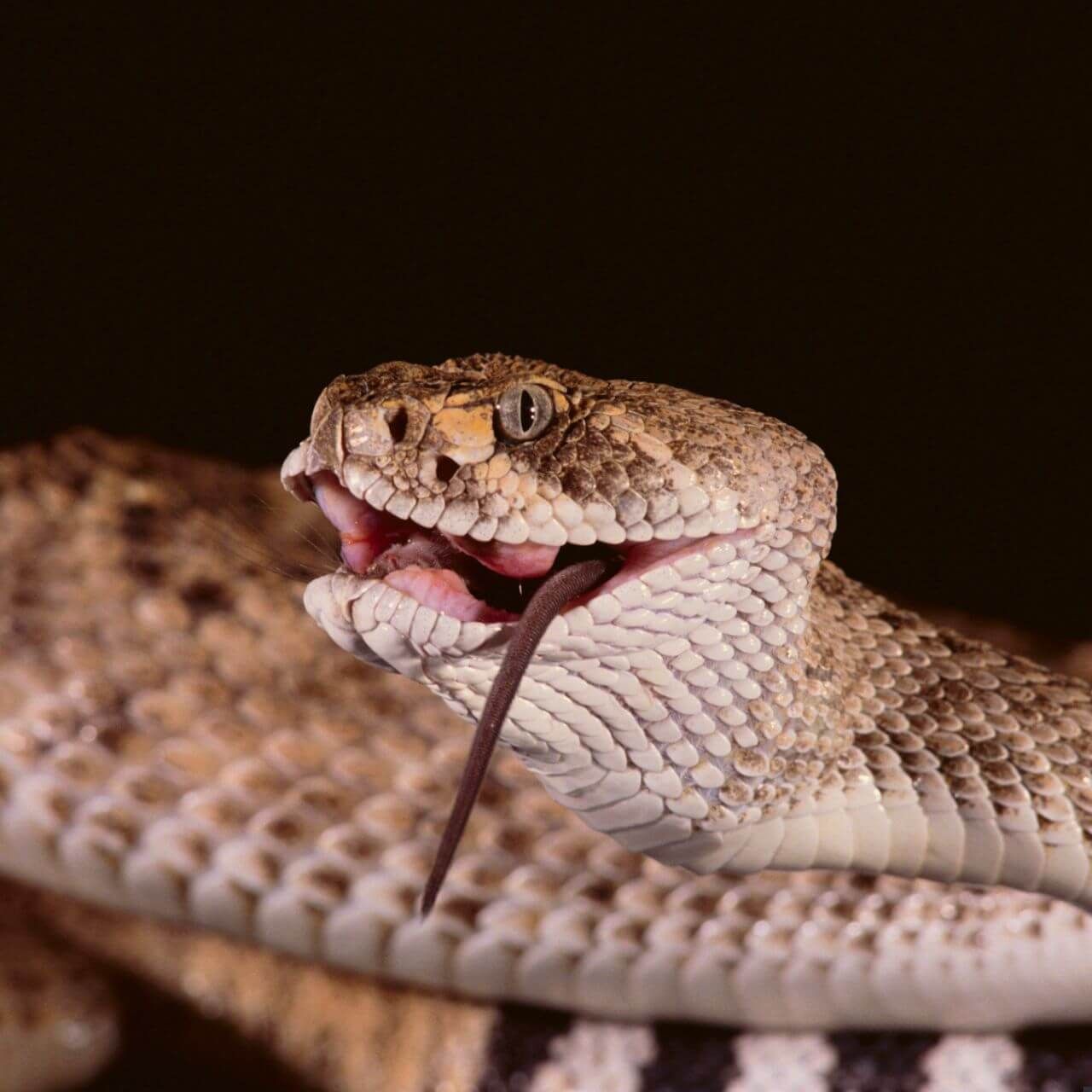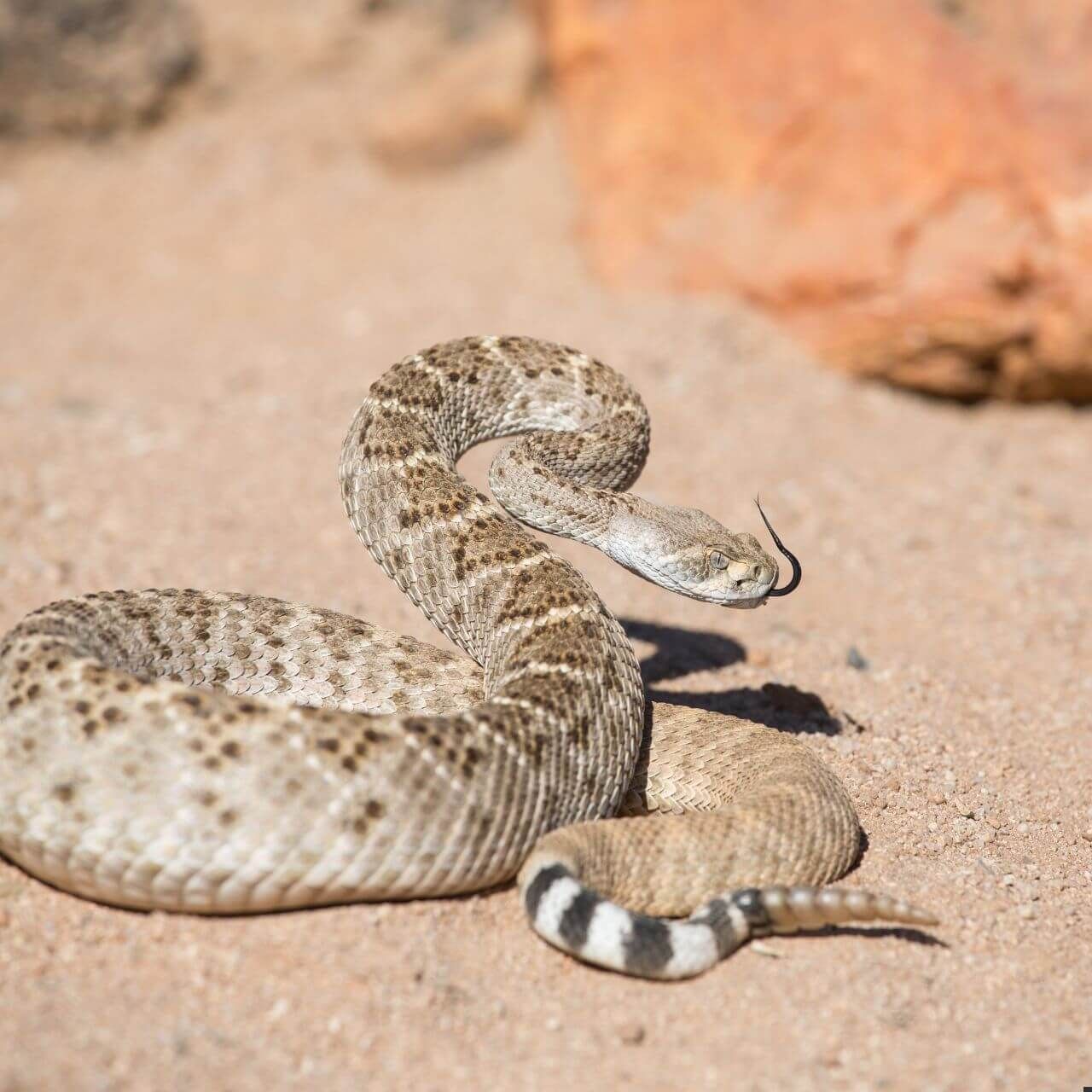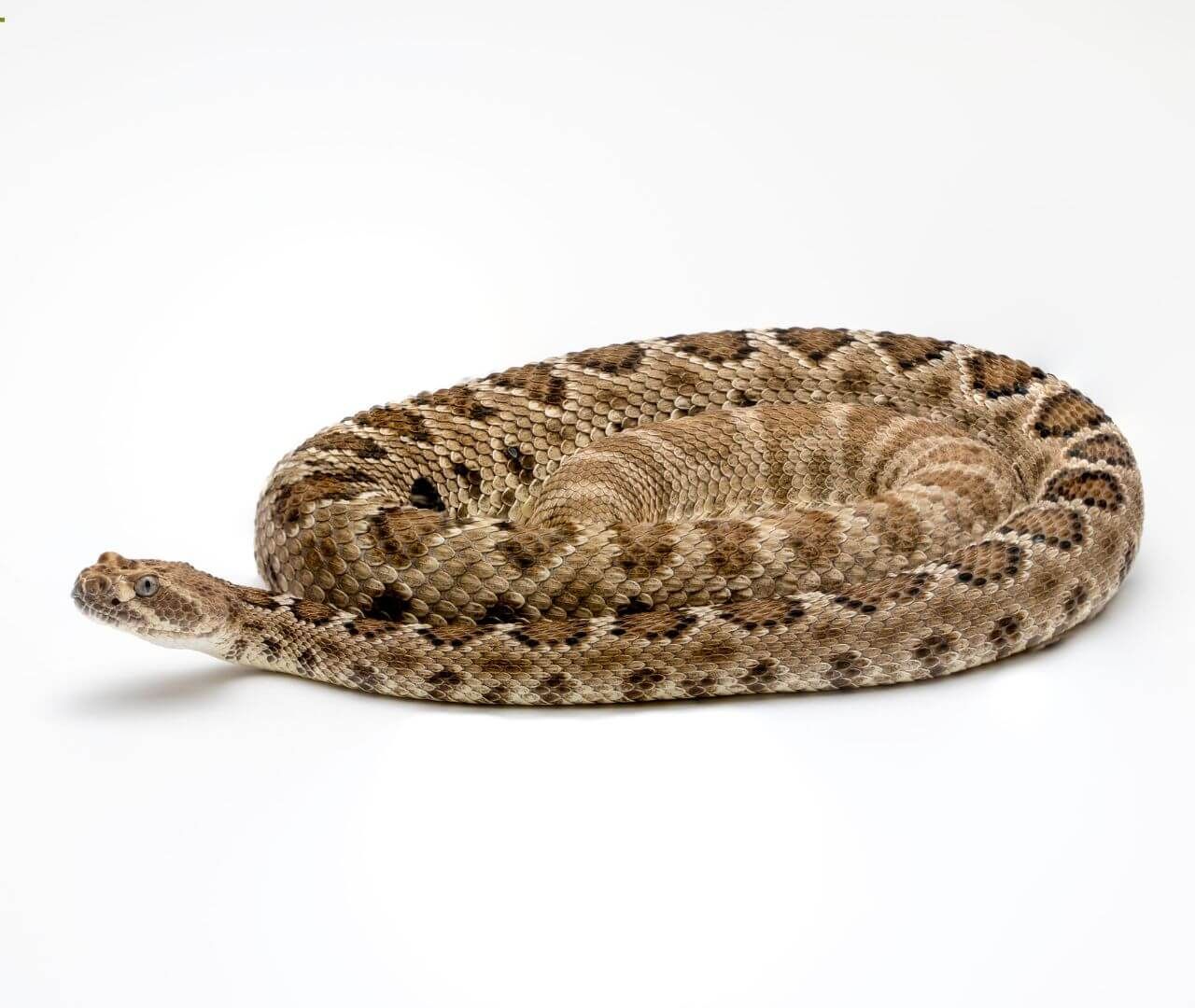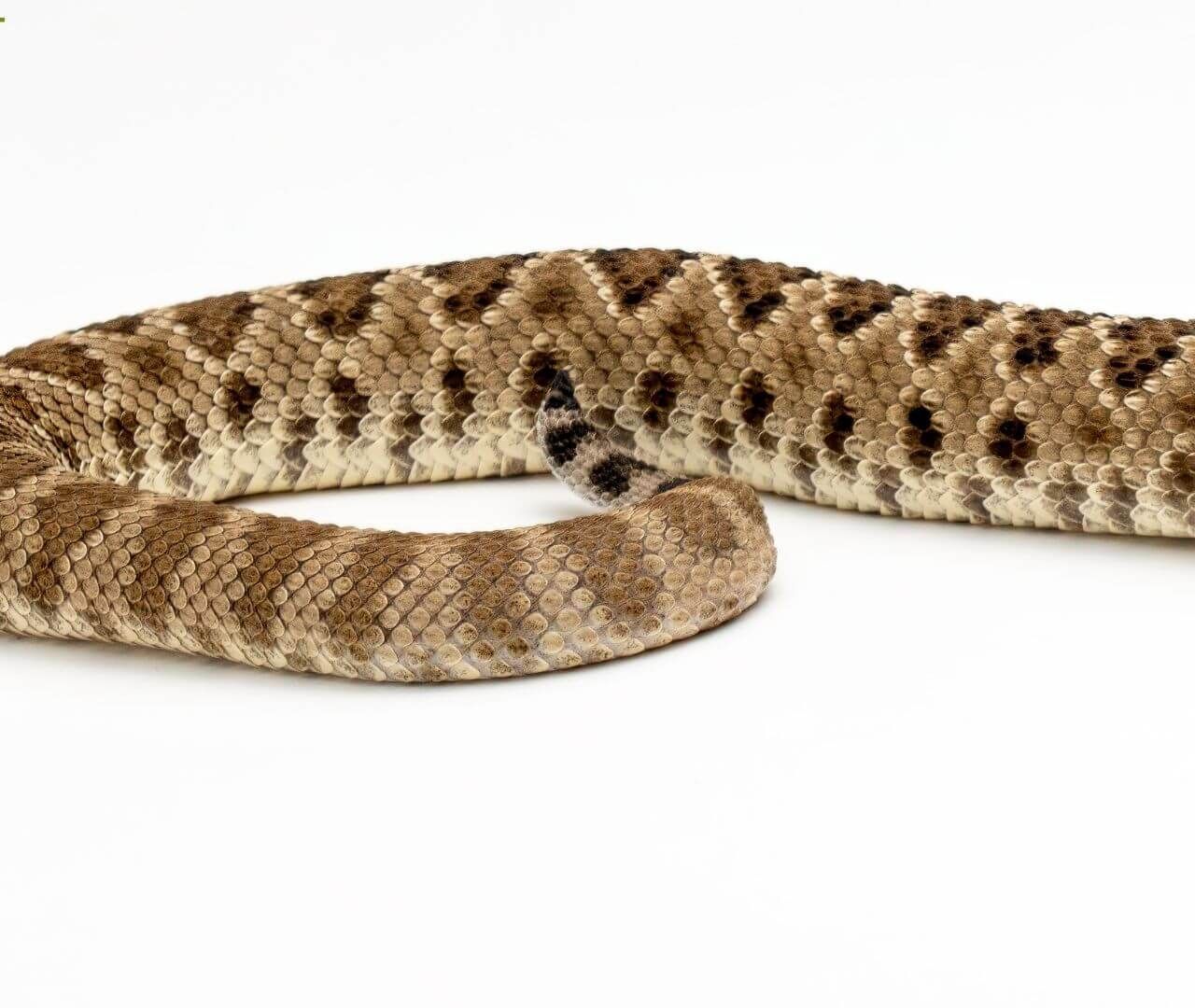Rattlesnakes

Let's Learn About Rattlesnakes
Word of the Week
Gland
Glands are organs that animals have that produce a chemical or other substance. Humans have many glands. Salivary glands in our mouth produce saliva (spit) while sweat glands in our skin produce sweat.
Venomous animals, like rattlesnakes, have venom glands in their mouth that produce toxic venom.
Fast Facts

Where do rattlesnakes live?
Rattlesnakes live in North America and South America.
They are usually found in warm ecosystems, especially in deserts. They can also be found in forests, grasslands, and wetlands.
What do rattlesnakes eat?
Like all snakes, rattlesnakes are carnivores.
They use their sense of smell and heat sensing pits to find prey like rodents (mice, rats, & squirrels), birds, lizards, and other small animals. They easily kill prey with a venomous bite.


What traits do rattlesnakes share?
Rattlesnakes have many traits in common, such as...
- Potent venom
- A noisy rattle made of keratin
- Heat sensing pits
- The ability to smell with their tongue
- Rough, well-camouflaged scales
How many rattlesnakes are there?
There are 36 species of rattlesnakes with many subspecies.
Several species of rattlesnakes are threatened with extinction due to threats like habitat loss and hunting. Thousands of rattlesnakes are killed each year during rattlesnake roundup events.

Species Spotlight
Santa Catalina Rattlesnake
Crotalus catalinensis
Santa Catalina Island is a small island in the Gulf of California. No humans live on the island, but there are several species of birds and reptiles, including a unique rattlesnake.
The Santa Catalina rattlesnake is endemic to the island, meaning it does not live anywhere else. It is a unique rattlesnake species because it does not have a rattle. Most rattlesnakes are born with one button and grow a new one each time they shed. The Santa Catalina rattlesnake is born with one button, but it never grows more. Instead, the old button falls off and is replaced with the new button with each shed.
Scientists hypothesize that the Santa Catalina rattlesnake lost its rattle because no large animals or land predators live on the island. Therefore, the rattlesnakes do not need to warn potential threats of their danger.
Unfortunately, the Santa Catalina rattlesnake does have threats. Invasive species, like domestic cats, were brought to the island by people. The cats hunt rattlesnakes and the prey that rattlesnakes rely on.
The Santa Catalina rattlesnake is listed as Critically Endangered by the IUCN. Few conservation programs are working to help Santa Catalina Island rattlesnakes in the wild, but fortunately, many zoos participate in captive breeding programs. You can support Santa Catalina Island rattlesnakes by supporting the zoos that participate in breeding programs.
BRAIN BLAST
Santa Catalina rattlesnakes are not the only rattlesnake whose rattle changed due to their environment. Research which other rattlesnake species are losing their rattle and discover why.
Conservation Corner
Rattlesnake Roundup
It is no secret that rattlesnakes get a bad reputation. Their venomous bite is feared by many. However, like all animals, rattlesnakes have a job in the environment. They keep populations of rodents and other small animals in check. Without them, the mouse and rat populations would rise.
It is important to leave rattlesnakes in nature to do their job. However, many states host rattlesnake killing events called rattlesnake roundups. Roundups in Texas, Oklahoma, and Alabama are hosted like carnivals or fairs as they kill thousands of snakes each year. Ranchers and other participants hunt rattlesnakes, often taking them from their burrows.
The rattlesnakes are brought to the fairgrounds where they take their venom and measurements, and then kill them. Awards are given to people who collect the most snakes and the biggest snakes. Rattlesnake roundup participants claim the venom is used to make antivenom, and the data collected is used by scientists, but none of this is true.
Rattlesnake roundups have negative effects on the environment. The best way to stop rattlesnake roundups is by using your voice. Write to policymakers in states that host roundups to let them know you do not support these events. Donate to organizations like Advocates for Snake Preservation that work to stop roundups. And, of course, do not participate. Do not attend rattlesnake roundups or kill rattlesnakes or any wild animals.
Learn More!
Glossary
Adaptation
The process by which a species becomes more fit for its environment over the course of several generations. It is a result of natural selection.
Ambush
Sneak attack.
Button
An individual segment of a rattlesnake's rattle.
Camouflage
The ability for an organism to blend into their surroundings usually to hide from prey or predators.
Carnivore
An animal that eats other animals.
Ectotherm
An animal that relies on the outside temperature to regulate their body temperature (reptiles and amphibians). Also known as cold-blooded.
Habitat Loss
When habitats are destroyed and changed into human-managed land such as farms or cities.
Infrared Radiation
A type of electromagnetic radiation that is created by objects that give off heat.
Keratin
A structural protein that makes up hair, nails, feathers, horns, and claws.
Pheromones
A communication chemical used to signal information to members of the same species.
Predator
An animal that hunts other animals for food.
Prey
An animal that is hunted and eaten by another animal.
Rattlesnake Roundups
A mass-killing event of rattlesnakes typically occurring in the southeastern United States.
Reptile
A group of ectothermic (cold-blooded) vertebrates that are covered in scales and generally lay eggs.
Species
A closely related group of animals with similar characteristics that are capable of reproducing (example: tigers).
Venom
A toxin that is injected into prey through teeth or a stinger.
Vomeronasal Organ
A sensory organ located in the mouths of snakes and several other animals used to detected chemicals from the air. It is also called the Jacobson's organ.





